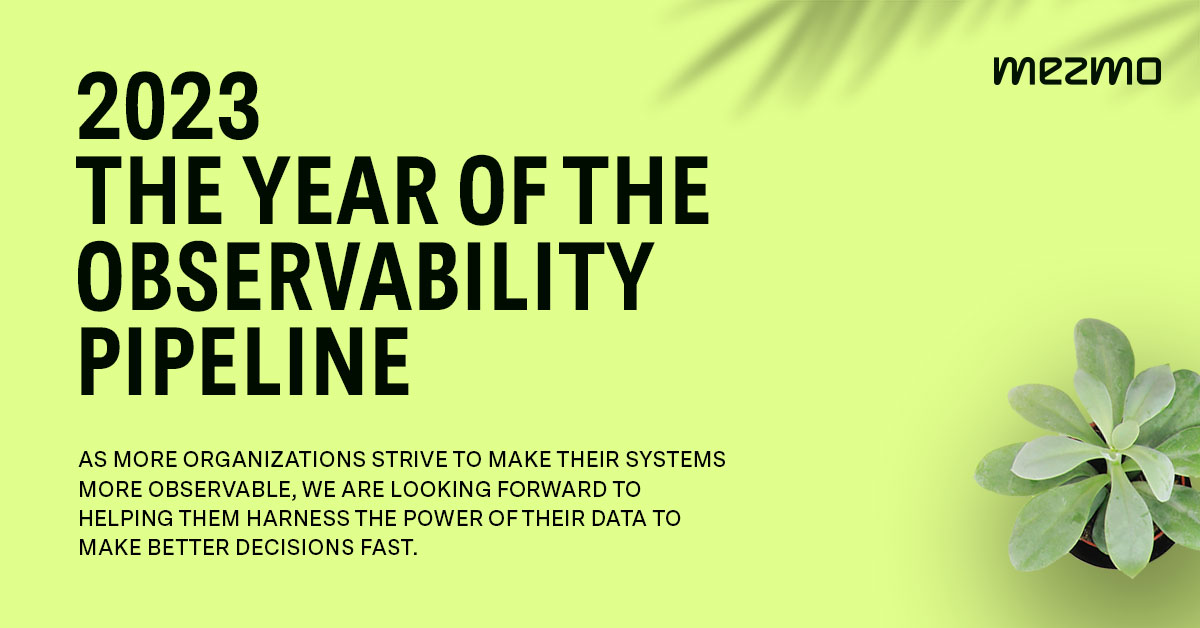The Year of the Observability Pipeline


At the beginning of each year, it is customary to reflect and identify areas we can continue to grow in 2023. Whether it’s joining the local gym, starting a new diet, or taking up a new hobby, this time is always full of promise to continually improve.
The same can be said for digital businesses of every size and across every vertical. Macroeconomic trends have especially made this time one of reflection for a number of organizations. They are asking questions on how to improve processes, reduce costs, and all while ensuring they are delivering the best experiences to their customers.
Of the many things that organizations are thinking about, one of them is how they are going to take advantage of observability best practices. To do this, they must harness their growing telemetry data volume and leverage it as a competitive advantage to make decisions faster.
Data Volume Is Growing, But Value of Data Isn’t
With applications and environments becoming more distributed, the amount of data being produced has increased significantly. Our own recent report with The Harris Poll showed that teams are seeing an average of 2 new data sources being added to their environments every year, while other reports show year-over-year data increases of upwards of 23%. However, while more data can empower teams with more insights, the fact of the matter is that the value derived from that data isn’t keeping pace with this growth. At Mezmo, we believe this is due to two main causes:
- Lack of control - Data volumes may be exploding, but the previous methods teams used to control them are outdated. Instead of being able to intelligently shape data to fit their needs, teams are left searching across various legacy solutions or relying on other groups to find those insights for them. Additionally, old paradigms of sending all data to a single pane of glass observability solution results in skyrocketing costs, with minimal insights as to which data is valuable and which isn’t.
- Lack of context - telemetry data isn’t inherently valuable in its natural state. Instead, they are typically unstructured, which makes it difficult to search for specific information. Additionally, different sources often create data that are formatted differently, making it difficult to merge disparate insights to make them more actionable. And with sensitive data moving across the organization, teams must tediously maintain and scrub that data to avoid security risks.
Observability Pipelines Provide Foundational Data Control
An observability pipeline is a solution that allows you to centralize your telemetry data (logs, metrics, and traces) from multiple sources, transform that data to fit your needs, and route it to various destinations. They are a centralized means of interacting with data to serve any use case across the organization, allowing teams to get the insights they need to drive crucial business decisions. Observability pipelines ensure that you have complete control over the data that is being generated across your environments. By shifting the control point away from more expensive observability solutions, you can empower your teams to more effectively shape data to fit their needs, as well as protect against the risks associated with storing that data for analysis.
Tip: Learn more about the key components of observability pipelines and how they can positively impact your business in our Observability Pipeline Primer.
Transform Data
The most crucial thing an observability pipeline can do for your teams is make sense of unstructured data types before it reaches their end destination. This is done through various processors that can shape and transform data to make it more actionable. This can be done with various parsers and data recognition capabilities that make it possible to recognize unstructured data patterns. And the best part of doing this within the pipeline is that you can shape the same data sets to fit various use cases downstream. For example, while one team in the organization may need data optimized to flow into a visualization tool for trend analysis, another may need the complete data set sent to a SIEM for threat hunting. Instead of maintaining two different data streams, an observability pipeline makes it easier to manage that level of transformation from a single control point.
Reduce Costs
Transforming data doesn’t just make it more actionable, but it also makes it more cost-effective. Pipeline processors can reduce data volume by removing unnecessary fields, sampling frequently occurring data types, or just dropping useless data altogether. Additionally, the routing control observability pipelines provide means that you aren’t left sending all of your data to an expensive observability solution. Instead, you can divert certain data types directly to cheaper object storage, thus saving on costs.
Tip: Want to learn more about how observability pipelines help save your budget? Check out our recent blog post.
Add Value to Transformed Data
With every new year, there is excitement around new technologies and best practices. As more organizations strive to make their systems more observable, we are looking forward to helping them harness the power of their data to make better decisions fast.
Mezmo recently unveiled its brand-new Observability Pipeline solution to help organizations control and transform their data to extract maximum value. To learn more, and see the platform in action, contact us today.
SHARE ARTICLE
RELATED ARTICLES



























